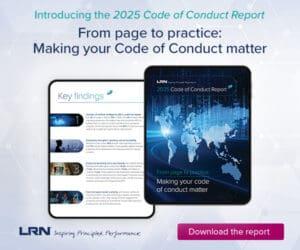In the #MeToo era, with allegations of workplace misconduct on the rise, organizations need a quick and accurate way to evaluate claims. Hanzo’s Sean Freidlin asserts that the internet is a hotbed of potential evidence — if you can sort through it and make sense of it all.
They say, “where there’s smoke, there’s fire,” but that’s not always true. Sometimes the oven’s just dirty, creating a lot of noise and fuss but no real risk of fire.
Likewise, a hotline complaint about workplace misconduct might — but doesn’t necessarily — indicate that there is workplace misconduct. There are plenty of times when allegations and whistleblowing are more about blowing smoke and less about an honest-to-goodness fire. The complainant may be disgruntled about some other issue or may be reporting overheard rumors or gossip that have been twisted beyond the truth. The bad news is that even that smoke can damage your workplace if you don’t get it under control.
What organizations need is a way to tell — quickly — when there’s really a fire and when there’s just a lot of smoke, so they can respond appropriately.
The Problem: An Overwhelming Number of Workplace Complaints
In recent years, there’s been a considerable rise in reporting of workplace misconduct. These claims range from the intensely personal — the #MeToo movement that uncovered a hidden epidemic of sexual harassment — to the very foundation of a $9 billion business, Theranos, revealed by a whistleblower to have apparently invented its blood-testing technology out of whole cloth. Organizations across the country are dealing with a flood of hotline calls, claims of unethical and discriminatory behavior and reports of noncompliant and outright illegal business practices.
Harassment bears the dubious distinction of being the fastest-growing of these problems. NAVEX Global, in its annual Ethics & Compliance Hotline Benchmark Report, found that harassment reports increased by an alarming 18 percent between 2016 and 2018. The Equal Employment Opportunity Commission echoed those findings, noting that in 2018 it “received 7,609 sexual harassment charges — a 13.6 percent increase from FY 2017 — and obtained $56.6 million in monetary benefits for victims of sexual harassment.”
All of this reporting leaves organizations in a difficult position. For each and every accusation, they must determine whether they need to put out a fire or just dissipate the smoke. It’s damaging to be wrong either way: While misconduct obviously must be detected and corrected before it can rip through the entire community, baseless smoke should also be headed off before it destroys reputations or workplace morale.
And it’s not just a smart business practice to investigate claims; in its updated April 2019 Evaluation of Corporate Compliance Programs guidance the Department of Justice advised that organizations should develop a method to assess the seriousness of any allegations and determine which merit further investigation and data collection.
But that’s not what’s happening. NAVEX Global found that only 41 percent of harassment reports and 29 percent of discrimination reports were substantiated in 2018. And organizations reached those conclusions too slowly; the median case closure time for all investigations was 40 days, considerably beyond the recommended timeframe of 30 to 32 days.
Compliance teams are failing in their mission to promptly investigate and substantiate — or question — the majority of reports they receive. Why? They can’t find evidence, especially about harassment or discrimination, quickly enough.
The catch is this: There’s tons of evidence out there, if only compliance teams were looking in the right place.
The Solution: Online Data
There’s a wealth of public data available about practically everyone, but many investigators are missing it. That’s because they’re confining themselves to the office, auditing work email accounts and conducting slow, labor-intensive interviews. Meanwhile, the evidence they need is somewhere else altogether: on the internet.
That evidence may be on Reddit, Facebook, LinkedIn or Twitter. Perhaps it’s on a personal blog, a forum chatroom or even a profile on a dating website. Wherever people are active online, their true behavior — what they try to hide in the office — has a tendency to show up.
That’s what happened with a schoolteacher who complained about her Latino and African-American students on Facebook, claiming “I’m not a teacher — I’m a warden for future criminals!” (She was fired for making that statement in violation of her school’s social media policy, but it sure would’ve been compelling proof had she been accused of racial discrimination.) And we all watched in real time as a PR employee lost her job by tweeting, “Going to Africa. Hope I don’t get AIDS. Just kidding. I’m white!”
But how can you find that type of compelling evidence in a consistent and intentional manner under the time pressure of a misconduct investigation? After all, there are hundreds of potential apps, platforms, social media channels and other forms of online communication that a respondent might have used and hundreds more potential usernames and profiles to sort through to find posts written by the right person.
Technology — specifically artificial intelligence — is the answer, offering a fast and easy way to identify specific online profiles and analyze their contents. For example, with improvements in natural language processing, computers can now assess not just the words used in a document, but also the emotion or sentiment underlying those words. That means that technology is capable of discerning the meaning of both online text and subtext and of spotting the patterns hidden in that meaning. And, of course, it can do so in a fraction of the time that it would take a person to poke around online and read through posts.
The web is full of potential evidence that can help to substantiate — or throw into question — workplace claims of all types. When compliance teams tap into the power of online data, coupled with advanced technology, they’ll find themselves able to complete misconduct investigations faster, reaching better-informed decisions.
Don’t assume that where there’s smoke, there’s fire. Find out which is which so you can take the right corrective action.



 Sean Freidlin is Senior Product Marketing Manager, Compliance for
Sean Freidlin is Senior Product Marketing Manager, Compliance for 








